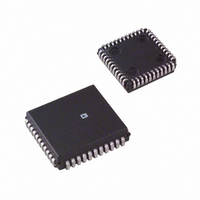AD8600APZ Analog Devices Inc, AD8600APZ Datasheet - Page 14

AD8600APZ
Manufacturer Part Number
AD8600APZ
Description
16 CHANNEL 8-BIT MULT.DAC
Manufacturer
Analog Devices Inc
Datasheet
1.AD8600APZ-REEL.pdf
(16 pages)
Specifications of AD8600APZ
Rohs Compliant
YES
Settling Time
1µs
Number Of Bits
8
Data Interface
Parallel
Number Of Converters
16
Voltage Supply Source
Analog and Digital, Dual ±
Power Dissipation (max)
175mW
Operating Temperature
-40°C ~ 85°C
Mounting Type
Surface Mount
Package / Case
44-PLCC
Lead Free Status / RoHS Status
Lead free / RoHS Compliant
Available stocks
Company
Part Number
Manufacturer
Quantity
Price
Company:
Part Number:
AD8600APZ
Manufacturer:
Analog Devices Inc
Quantity:
10 000
Part Number:
AD8600APZ
Manufacturer:
ADI/亚德诺
Quantity:
20 000
Company:
Part Number:
AD8600APZ-REEL
Manufacturer:
Analog Devices Inc
Quantity:
10 000
AD8600
The functionality of this circuit is shown in the scope photo in
Figure 24 The top trace is the control ramp, which goes from
0 V to 1.25 V. The bottom trace is the output of the AD600.
The input is actually a 12 mV p-p, 10 kHz sine wave. Thus, the
bottom trace shows the envelop of this waveform to illustrate
the increase in gain as time progresses. This ramp was gener-
ated under control of the 68HC11 using the “ramp” subroutine
as mentioned above. The slope of the ramp can easily be
lengthened by adding some delay in the loop, or the slope can
be increased by stepping by 2 or more LSBs instead of the cur-
rent 1 LSB changes.
CONTROL
OUTPUT
0.2V/DIV
1V/DIV
AD600
GAIN
Figure 24. Time Dependent Gain of the AD600
200µs/DIV
–14–
Glitch Impulse
A specification of interest in many DAC applications is the
glitch impulse. This is the amount of energy contained in any
overshoot when a DAC changes at its major carry transition, in
other words, when the DAC switches from code 01111111 to
code 10000000. This point is the most demanding because all
of the R-2R ladder switches are changing state. The AD8600’s
glitch impulse is shown in Figure 25. Calculating the value of
the glitch is accomplished by calculating the area of the pulse,
which for the AD8600 is: Glitch Impulse = (1/2) (100 mV)
(200 ns) = 10 nV sec.
50mV/DIV
V
OUT
Figure 25. Glitch Impulse
200ns/DIV
200ns/DIV
REV. 0









